Best Backpacking Water Filters and Purifiers of 2024
Check out the best backpacking water filters and learn what factors to consider when choosing one for your next adventure.

When I’m backpacking, the last thing I want to do when I sit down to rest is get an arm workout by pumping water through my water filter. Luckily, water filters have come a long way since I first started backpacking in 2005. You no longer have to biceps of steel in order to refill your water bottle.
Regardless of your preferred water filtration method, a reliable backpacking water filter is a key essential for any multi-day outdoor adventure. Parasites and bacteria live in the lakes and rivers that you rely on to stay hydrated in the backcountry. Giardia, which comes from fecal matter, is the most common and can cause abdominal cramping, nausea, diarrhea, and vomiting – not exactly what I’m looking for when I’m miles away from a toilet.
There are dozens of different water filters and purifiers available. Filters get out bacteria and sediment, while purifiers remove viruses. In this post, I share the best backpacking water filters and water purifiers, as well as tips for how to choose the right method for your adventures.

Best Backpacking Water Filters at a Glance
Filters
- Bearfoot Theory favorite: Platypus GravityWorks 4L System
- Best ultralight water filter: Sawyer Squeeze
- Best water filter for large groups: 10 L MSR AutoFlow XL Gravity Filter
- Best hand pump filter: MSR MiniWorks EX
- Best water bottle filter for day hikes: LifeStraw Peak Squeeze
Purifiers
- Best purifier for the muckiest of water: MSR Guardian Gravity Purifier
- Easiest for international travel: Grayl GeoPress
- Best backup water treatment drops: Aquamira
This post may contain affiliate links.
Save this post!
Enter your email & I'll send this post to your inbox! You'll also receive my weekly newsletter full of helpful advice for planning your adventures.
Best Backpacking Water Filters
As I share in more detail below, water filters remove bacteria and protozoa from water as well as small particles of dirt and silt. Water filters do not remove viruses. A water filter will suffice for 99% of backpacking trips in the US and Canada.
Platypus GravityWorks Filter System
Bearfoot Theory favorite
- Great for: Large groups, filtering a large amount of water at once, setting up a fixed campsite in the backcountry for a few days, car camping near a water source where there is no potable water available
- What I like: Comes with several different bottle top adapters, one of the faster gravity water filters on the market, comes with two bags
- What I don’t like: Can get clogged easily if filtering silty water, can be hard to fill bag in shallow water
The Platypus GravityWorks Filter is a gravity filter (as the name implies) and can filter 1.75 liters per minute.
The great thing about it is that it includes two 4 L bags, so you always have one for clean water. Alternatively, you can filter water straight into a bottle using one of the several bottle top adapters that fit Nalgenes, Klean Kanteens, and most other bottles.
To use it, you basically just fill up the dirty bag, hang it up, and let gravity do the rest! (Be sure that the filter is connected in the right flow direction).
The Platypus GravityWorks is the filter I used on the John Muir Trail, although I only used the dirty bag and filtered it into a few super lightweight Platypus Soft Bottles.
Looking for a bigger option? Snag the 6L system for group or family trips into the backcountry!
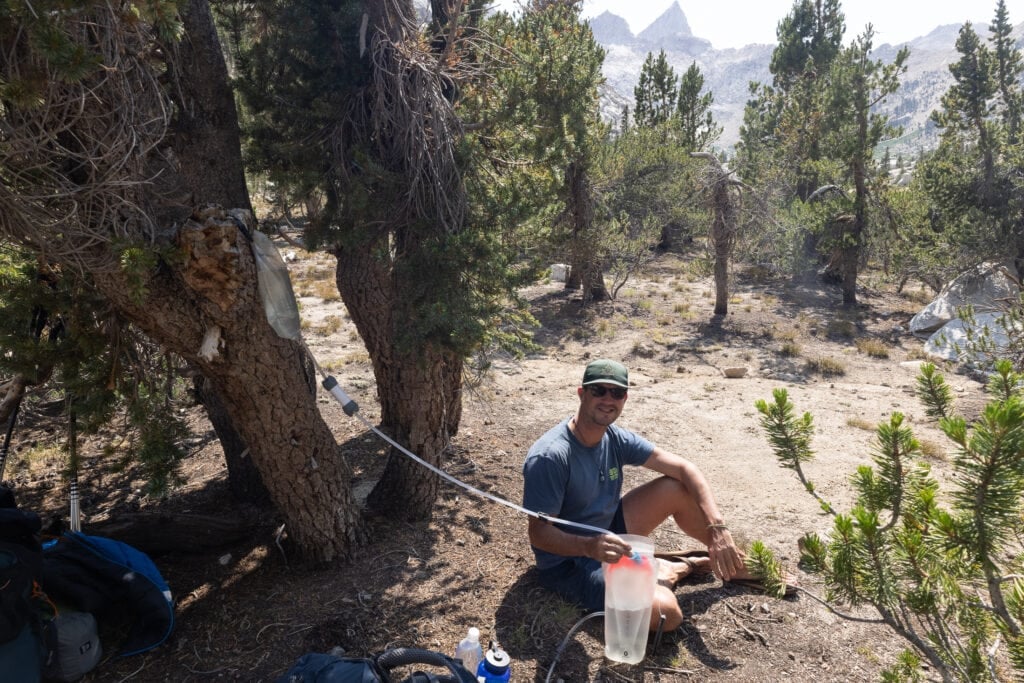
Sawyer Squeeze
Best Ultralight Water Filter
- Great for: long day hikes, ultralight backpacking trips, thru-hiking, solo backpackers
- Pros: very lightweight, versatile, comes with a syringe to backflush, budget-friendly
- Cons: ceramic filter can crack in cold temperatures, filters a small amount of water at a time, included water bag isn’t very durable
The Sawyer Squeeze is one of the smallest and most lightweight water filters out there weighing in at only 3 ounces.
In addition to being lightweight, the Sawyer Squeeze is also very versatile. Many backpackers use this filter in combination with a Smartwater bottle (or two) because it attaches easily.
You can also use it by:
- Squeezing water straight into your mouth or a water bottle
- Attaching it to the hose of a hydration reservoir and drinking through the nozzle
- Using the included straw to drink water straight from a source
- Setting it up as a gravity filter
However, this filter does take a substantial amount of time to filter multiple liters and requires some manual effort in squeezing the water through the filter (unless you set it up as a gravity system).
It can also get clogged easily and the filter is ceramic, which means it can freeze in cold temps. A quick fix to prevent this is to put it with you in your sleeping bag at night.
That being said, it’s still a great budget-friendly, ultralight filter that’s super popular among backpackers.
10 L MSR AutoFlow XL Gravity Filter
Best Water Filter for Large Groups
- Great for: large groups, car camping trips where there is no potable water available
- Pros: easy to filter large quantities of water, has a mesh screen to keep larger debris from clogging the filter
- Cons: would be nice to have the option to purchase a smaller bag when not backpacking with a large group
If you’re looking for a high-volume backpacking water filter for group backpacking trips, the MSR AutoFlow XL Gravity Filter comes with a 10L bag so you can minimize trips to the river.
It can filter 1.75 L of water per minute via gravity, providing you with clean drinking or cooking water quickly and hassle-free.
The larger bag is also handy if you aren’t camping directly near a water source since the 10L capacity will minimize trips to collect water.
It also weighs the same as the 4L Platypus Gravity Works so the extra capacity doesn’t add any weight.
I also love that the bag has an integrated mesh lining to keep larger debris from entering the filter.
While this filtration system might be overkill for most people going on backpacking trips solo or with a friend, this is the best setup if you’re with a large group in the backcountry or are going to be camped far away from your water source.
MSR MiniWorks EX Water Filter
Best Pump Water Filter
- Great for: People who prefer a hand pump filtering system, trips with shallow rivers or streams
- Pros: Can be disassembled in the field and cleaned without extra tools
- Cons: Not compatible with water bottles other than a wide-mouth Nalgene, pumping water can be tedious and require a lot of manual effort, slightly heavier than other options on this list
The MSR MiniWorks Ex Water Filter is one of the best hand pump water filters out there if you prefer a pump filter over a gravity filter.
It has a ceramic/carbon filter to remove bacteria and protozoa and it can process up to water at 1 liter per minute. The bottom can also easily screw onto an MSR Dromedary Bag or a wide-mouth Nalgene bottle for easy operation.
This filter comes with a cleaning kit for easy cleaning in the field.
It’s important to note, though, that hand pump filters are our least favorite type of water filter due to the ease of newer gravity and squeeze style filters. But for people who like the old-school techniques, this is the best pump-style water filter.
LifeStraw Peak Squeeze Water Filter System
Best Water Bottle Filter for Day Hikes
- Great for: Trail runs, day hikes where water sources are plentiful
- Pros: easy to stash when empty, faster than other filter options
- Cons: Requires frequent refills since it filters straight from the bottle (which is not ideal for most backpacking trips where freshwater is not always readily available)
The LifeStraw Peak Squeeze Water Filter is great because it’s super versatile and straightforward to use. You can drink straight from the nozzle, remove the filter from the bottle and use it as a straw, attach the filter as an inline filter on your hydration reservoir, or even set it up as a gravity filter.
The bag is designed to be very durable, so you don’t have to worry about rips, tears, or punctures. The threads on the filter also allow it to be screwed onto nearly any disposable water bottle. Plus, for each LifeStraw purchased, 1 child in a developing community receives safe drinking water for an entire school year – how cool is that?
While a water bottle filter is not recommended for backpacking (you need to be able to carry a lot more water), it’s a great solution for day hiking.
Best Backpacking Water Purifiers
Unlike water filters, water purifiers kill or remove microorganisms including viruses either through a filter or by UV light. These are great for backpacking or traveling in developing countries or areas where the water sources could be contaminated by agricultural runoff.
MSR Guardian Gravity Purifier
Best Water Purifier for the Muckiest of Water
The MSR Guardian Gravity Purifier works essentially the same as the MSR AutoFlow XL Gravity Filter above, but its 2-stage purifier removes harmful viruses as well.
If you’re planning a multi-day trek with a group of friends to a developing country, this is an essential piece of gear. This is also perfect for trips where the water sources can be sketchy, such as a rafting trip through the Grand Canyon.
Grayl GeoPress Water Filter & Purifier Bottle
Easiest Water Purifier for International Travel
- Great for: International travel, short day hikes, backpacking trips with ample water
- Pros: Filters water quickly, requires no setup, easy to use
- Cons: The amount of water you can filter and carry is constrained by the size of the bottle (unless you carry additional containers for the filtered water)
The Grayl GeoPress Water Purifier Bottle is a great companion for any day hike, backcountry adventure, or international trip. The press system can filter out most harmful microorganisms including bacteria, protozoa, and viruses.
The filter is also replaceable and is good for up to 350 cycles.
I took the Grayl on my trip to Patagonia and I loved how easy it was to use and the peace of mind I had while drinking tap water in another country. I even used the Grayl on my 5-day W backpacking trip where it was super easy to fill up from streams!
The Grayl has a 24 oz. capacity, so if you’re relying on it for hiking or backpacking, I’d recommend packing a few collapsible 1L soft water bottles so you can easily store extra filtered water from your Grayl.
While this may not be the lightest or most compact water filter for backpacking, it’s great for long day hikes and other adventures where there’s ample water, especially in countries where viruses may be present.
When traveling, it also helps eliminate the need for single-use water bottles. For that, I give it a big thumbs up!
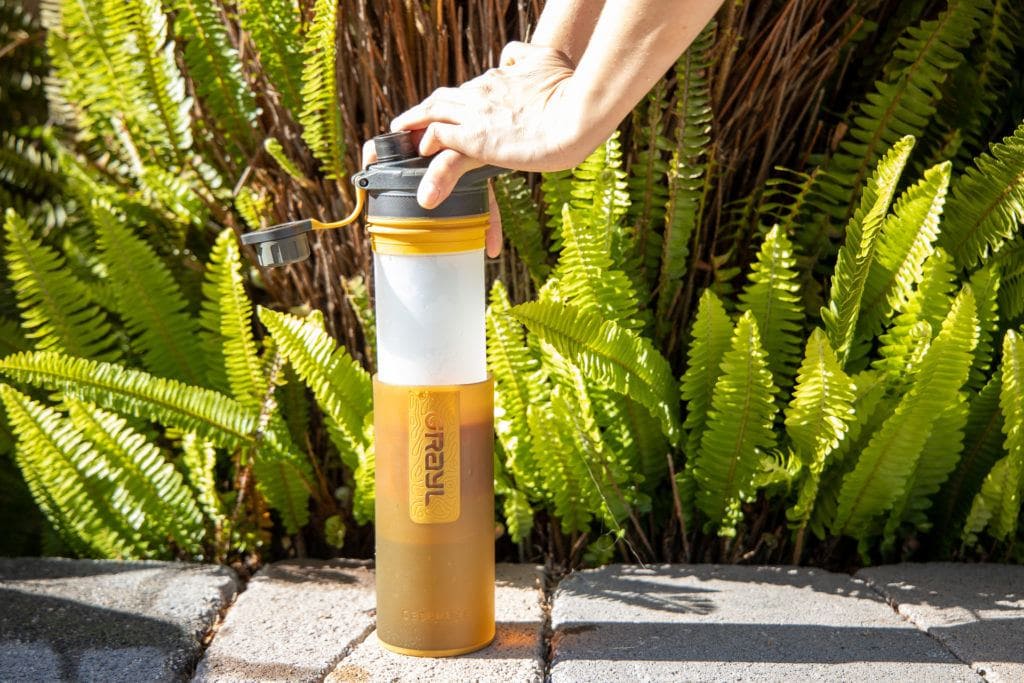
Aquamira Water Treatment
Best Backup Water Treatment Drops
- Great for: Carrying as filtration backup, backpacking trips with clear-running water
- Pros: Super lightweight, reliable with no risk of pieces getting broken or malfunctioning, inexpensive
- Cons: You need to wait at least 30 minutes for the drops to work – some microorganisms can even take up to 4 hours to be killed, does not remove sediment or dirt
If you know you’ll have clear, running water and you have time to wait for purification drops to work (which can take up to 4 hours), then the two-step Aquamira Water Treaments Drops are a great choice.
While I don’t recommend water treatment drops as your primary filtration method since these drops don’t filter out sediment and can taste a bit funny, I always carry drops as backup in case my main water filter fails in the backcountry.
These drops don’t contain iodine or chlorine, which can make water taste funky. Instead, they contain Chlorine dioxide (not the same as chlorine), a chemical that has been proven to kill 99.9% of bacteria, protozoa, cysts, and viruses.
Keep in mind that this not a filtration system, so you’ll need fresh, clear water unless you’re ok with drinking some silt and sediment.
If you prefer tablets over drops, check out the Katadyn Micropur Purification Tablets.
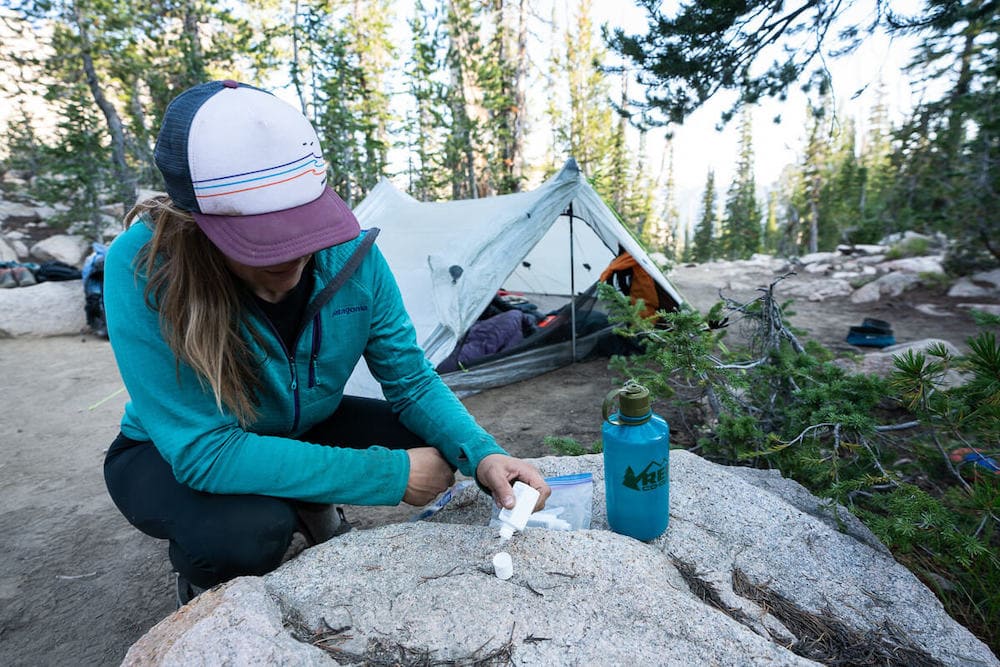
Different Types of Water Filters
Backpacking Water Filters
Backpacking water filters are the most common option if you’re hiking and camping in countries like the US and Canada.
They work by forcing water through a fine membrane, which traps small organisms and particles. This means that they’re effective at removing things like bacteria and protozoa.
However, water filters are not able to remove viruses, which can be found in water sources in developing countries or in places with heavy agricultural activity.
There are several different types of backpacking water filters to consider:
Gravity Water Filters
Gravity filters filter water by using gravity–there is no squeeze or pumping necessary.
They generally consist of a bag with a hanging mechanism that you fill with the water you want to filter, a filter, and a long tube that can be used to fill whatever container you’d like.
Simply fill the bag from the water source, hang it up, and gravity carries water down through the filter and into a new container.
Gravity filter pros
Gravity filter cons
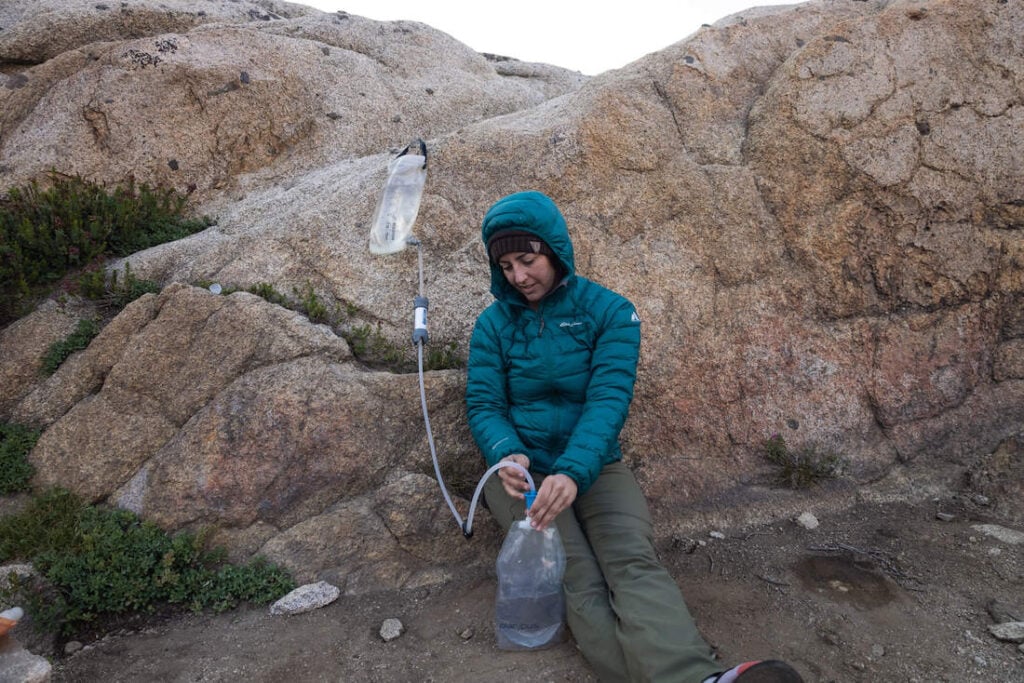
Squeeze Water Filter
Squeeze water filters require manual effort to squeeze water through the filter. They’re typically very lightweight, compact, and budget-friendly. Squeeze filters are perfect for solo backpackers who don’t need to filter a lot of water at once.
These types of filters need to be backflushed more often than other filters to prevent clogging which reduces the flow rate and makes it harder to squeeze water through.
Backflushing is how you clean the filter, and this is done by using a syringe to shoot water through the filter in the opposite direction that water filtration takes place. Most squeeze water filters come with a syringe cleaning system to make this process simple.
Squeeze filter pros
Squeeze filter cons
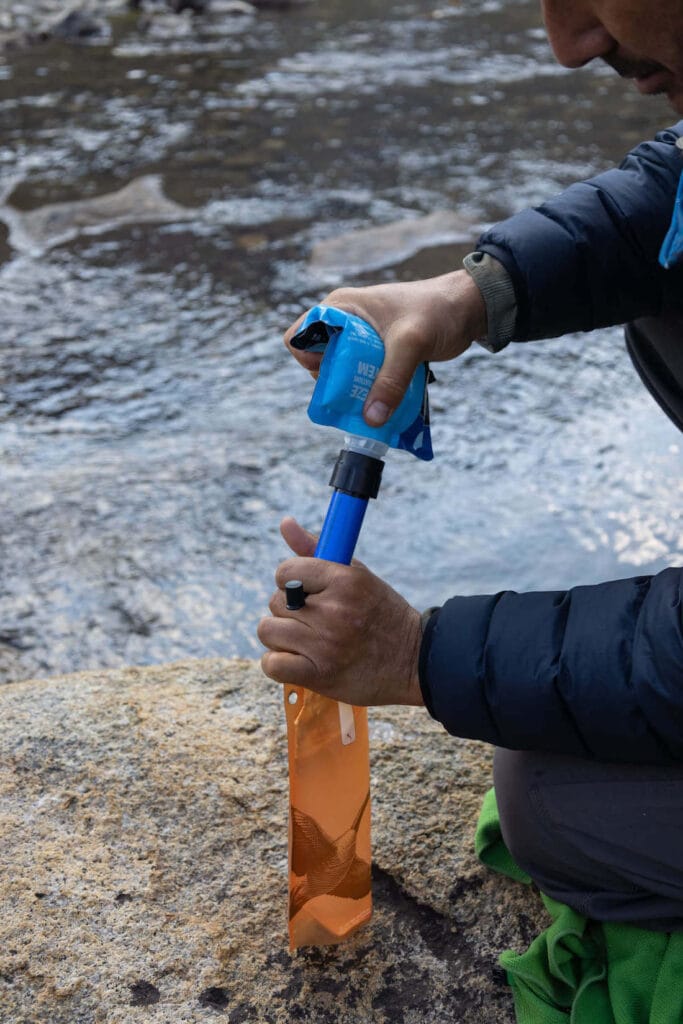
Pump Water Filter
Pump water filters require manual effort to pump water through the filter. Most water filter pumps come with two hoses, one that you drop into the body of water you want to filter from and one that transfers the filtered water into your water container of choice.
These types of water filters are versatile because they can filter from shallow running water and the filter itself is replaceable, but they do require you to sit alongside the water source and pump.
Pump filter pros
Pump filter cons
Backpacking Water Purifiers
Water purifiers are a better choice for backpacking and traveling in developing countries. In the US, you may consider a water purifier if you have a trip where the water sources are sketchy or areas with lots of agricultural activity.
Purifiers work by using chemicals or ultraviolet light to kill viruses, bacteria, and other microorganisms. This makes them much more effective than filters for purifying water.
However, they can be bulkier and more expensive, so they’re not always the best choice for backpacking, especially if you’re focused on trips here in the US.
Here are the most common options for backpacking water purifiers:
Ultaviolet Water Purifiers
Pen-style UV light water purifiers use UV light to treat water. You basically fill a container with water and swirl the pen around until the UV light turns off (which usually takes a minute or so).
They’re lightweight, super easy to use, won’t clog or need to be replaced, and they can easily treat water for a large group.
UV Light Purifiers also virtually eliminate viruses in addition to bacteria and protozoa while most water filters do not eliminate viruses.
The downside to these purifiers is that they don’t filter out sediment and they require batteries or a charger to work. If you choose to use a UV Light water purifier, always carry a backup water filtration option as these can be finicky to work.
UV light purifiers pros
UV light purifiers cons
Water Filtration Bottles or Straws
Water filtration bottles have a built-in purifier. You basically fill the bottle with water and the water is either filtered as you sip through the filter or pressed through the filter like a coffee press.
They’re very easy to use and provide a method of filtering and drinking all in one bottle.
However, the amount of water you can filter and carry is constrained by the size of the bottle, so they’re really only useful for basecamp or backpacking trips with near-constant access to water.
Water filtration bottle pros
Water filtration bottles cons
Purification Tablets or Drops
Water purification tablets or drops virtually eliminate bacteria, most protozoa, and viruses from water. They are very easy to use: Simply drop them into the water you gathered to treat, follow the instructions, and wait.
The downsides to tablets and drops are that they do contain chemicals, so they can leave a bit of an iodine taste, and they’re not recommended for pregnant women or people with thyroid conditions. They can also take up to four hours to completely kill some microorganisms (which is a long time if you’re thirsty after a big day of backpacking!).
While I wouldn’t recommend tablets or drops as your main purification method for backpacking, it’s always good to have a few of these on hand in case your primary filtration method breaks or in case you need them in a pinch while traveling.
Water purification tabs/ drops pros
Water purification tabs/ drops cons
How to Choose a Backpacking Water Filter
If you’re new to backpacking, here are a few tips on how to choose your first (or next) water filter for the backcountry.
1. Purification vs. Filtration
Let’s start here because it’s super important to know the difference. The difference between a water filter and a water purifier is the size of the microorganism each type eliminates.
Purifiers eliminates viruses while filters removes bacteria, protozoa, and sediment.
Bacteria in water sources is a concern within the USA and Canada, while protection from waterborne viruses is more important for international travel.
Filtration also removes sediment and silt, making the water more pleasant to drink while purification does not (unless it has a built-in filter like the Grayl GeoPress Bottle).
2. Weight
Weight is an important factor to consider for all of your backpacking gear and water filters are no exception, especially on a long-distance trip.
While not always the case, there tends to be a tradeoff between weight and speed of filtering. The smaller and lighter the filter, generally the longer the filtration process.
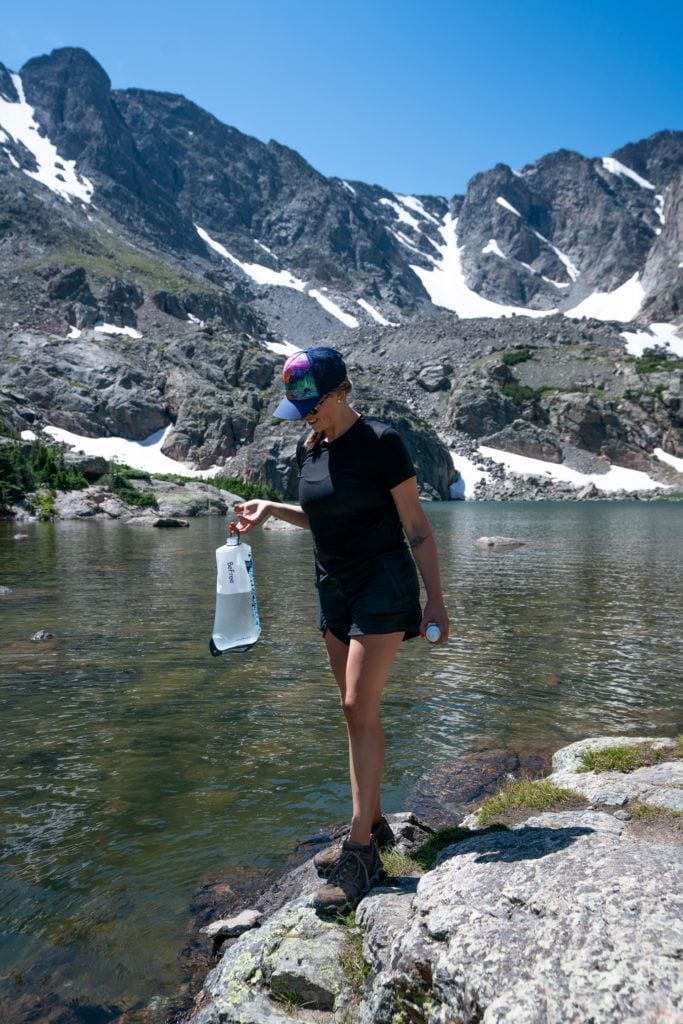
3. Filtration or Purification Speed
How patient are you? Some filters are speedy, while others take quite a bit of time. It’s also important to consider how many people you will potentially be filtering water for since more people means more water and more time.
Using chemicals, such as chlorine or iodine to purify water can take up to 4 hours while other filters can do the job within minutes.
If you are on any kind of backpacking trip, whether just a quick weekend trip or a thru-hike of a long-distance trail, time is of the essence–remember you came to explore the outdoors and you will not want a treatment method that takes a long time!
4. Type of Backpacking Water Filter
As I covered at the beginning of this post, some filters require a simple set-up and then allow you to sit back and relax while your water is filtered. For example, gravity filters work by using gravity to filter water from one bag to another.
Other filters require active participation–meaning you have to physically filter the water usually by either squeezing or pumping it through the filter.
It’s important to also consider that some backpacking water filters are ceramic and cannot be exposed to extremely cold temperatures or else they will crack.
5. Cleanliness of Water Source
Different elements can murk up water in varying ways such as glacial sediment, leaf debris, and/or mud stirred up by a recent rainstorm. If you plan to use tablets of chemicals to purify your water you’ll also need to bring something to act as a filter to help you remove dirt and debris prior to filtering.
Depending on how congested the water is sometimes a simple bandana can act as a pre-filter.
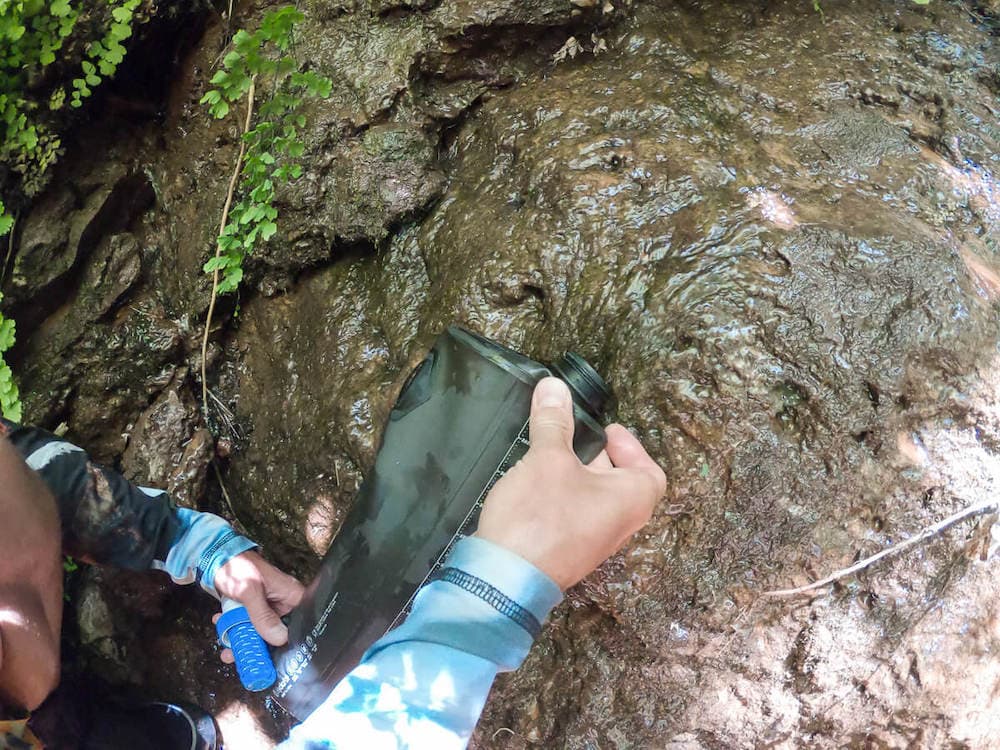
READ NEXT
Looking for more backpacking gear recommendations? Check out these related blog posts:
Do you have a favorite backpacking water filter or purification system? What has worked best for you? What questions do you still have? Leave a comment below!

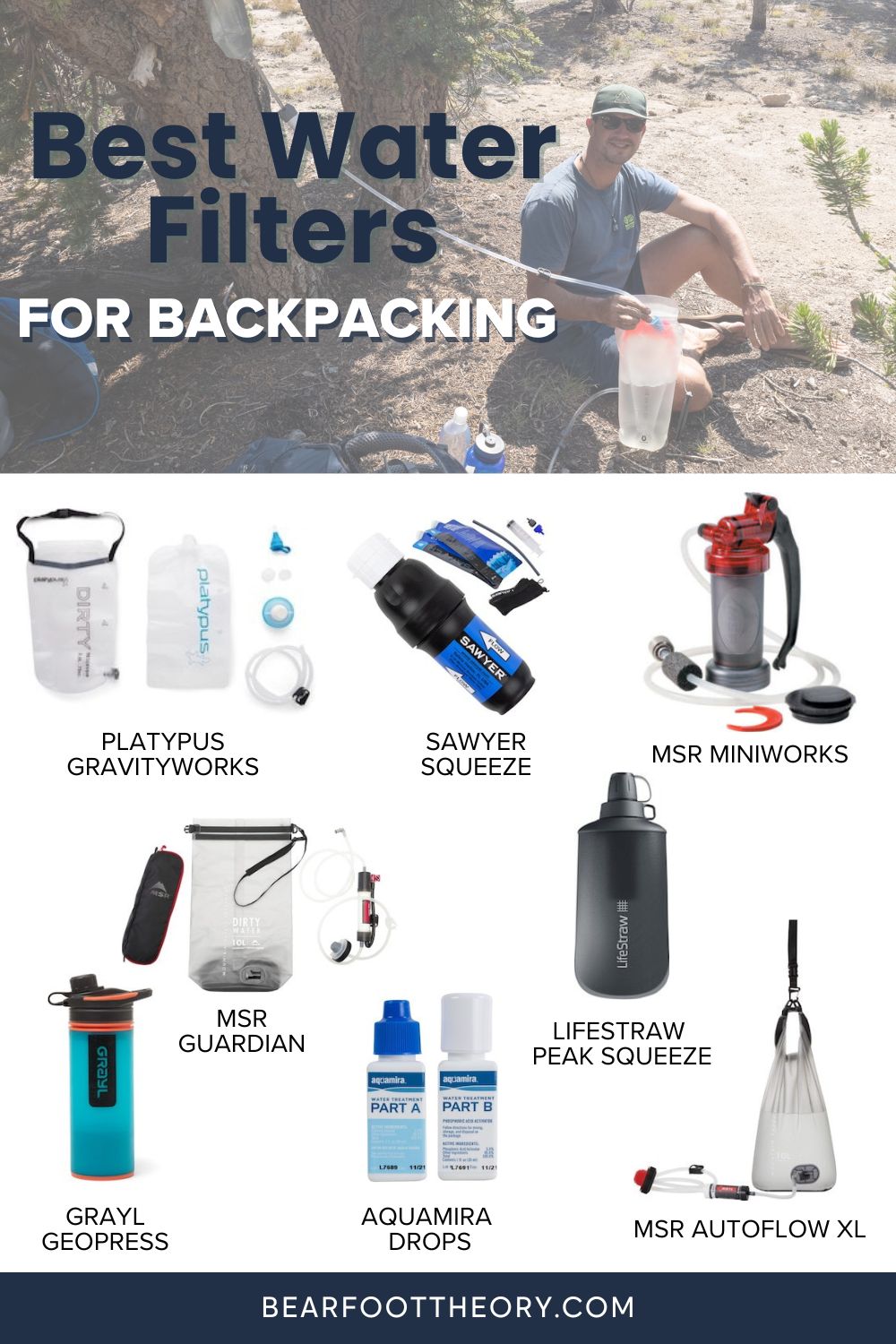
Very nice article. Great collection of the most popular options. I believe that pretty much any filter should be prevented from freezing, rather than simply the ceramic versions. And I have actually used a Gravity Works while hiking by simply holding the dirty bag up over my shoulder and the clean bag down at my side. By the time I hiked the one mile back to the main trail from a lake, I had 4 liters of clean water. Trees are not required, but they are certainly appreciated
Thanks Bill! To be safe it is definitely best to protect all filters from freezing, thanks for pointing that out! That so fun to hear how you used the Gravity Works filter “on the go”! Why wait for water for filter when there is so much to explore? Hope you have some great adventures planned for 2017!
This post is the perfect timing for me! I am starting to get into backpacking (I have been a devote car camper!) and need a filter. I just got a mummy sleeping bag (goodbye huge two person bag!). Thank you for the research, I will be saving this for when I make my purchase!
Thanks Katie! So great to hear you are venturing into backpacking! We are going to post this month a guide to purchasing a sleeping bag for backpacking. Any other big gear items you’d enjoy seeing a guide on? Make sure to check out our one on sleeping pads and backpacking tents! Hope 2017 brings awesome adventures and memories for you!
This blog has been so helpful as someone who is just starting out. I don’t know if you could consider it a big gear item, but I think I guide on first aid kits would be helpful. Should I go with a pre-made kit or gather supplies myself. What do experienced hikers consider to be essential supplies? Thanks!
Thanks Lisa! Really appreciate the suggestion about doing a post on first aid kits. Cheers! Kristen
I’ve used a steripen, but the one I have only does a liter at a time, and it requires you to carry a bottle, not just a bladder, to sterilize. I think I’m going to try the Sawyer Squeeze instead.
Lynn, yes the Steripen definitely has some negatives to it but it is great if you travel internationally in the near future! I loved my Sawyer Squeeze on the PCT, hope you enjoy it as well. Cheers to new adventures ahead!
Great post!!
Steripen and Aquamira drops are great , however l do not like the chlorinated taste they produce.My preference is Sawyer Squeeze, but maybe it is time to look at some other options.
The Sawyer Squeeze can also be set to do gravity filtering with some MacGuyvering – adds a few ounces but is very worth it. See: http://sectionhiker.com/myog-a-gravity-fed-water-filtration-system-using-the-sawyer-mini-water-filter-by-nathan-taylor/ – I adapted this system with my Sawyer Squeeze and it has worked well. Saves wear and tear on the Squeeze bags also which is a weak link of the system for many.
JP that is an awesome set-up! Thanks so much for sharing! You are totally right about the Sawyer bags as well–they aren’t the most durable for longterm use. Thanks for sharing your great set-up!
I have used the Sawyer mini on several multi-day backpacking treks and found it to be a great little filter. While it indeed needed a little muscle to squeeze the water through, it think the weight and price are a hard to beat combination. The versatility of being able to be screwed onto most water bottles and begin drinking right away is also a plus. At some point, I will likely upgrade to the squeeze as it looks like is has a little better output per squeeze.
Thanks Paul! Both Sawyer models are great, I definitely think once you try the Squeeze you won’t be able to downsize to the Mini! Hope you have some great adventures this year!
What about the LifeStraw?
The LifeStraw is a great backup but its a little difficult to use for a long backpacking trip or for a big group since it only filters water through the straw. It is difficult to use to filter a large quantity of water to use for cooking and/or to have readily available for consumption. Definitely a great backup though that is lightweight and easy to pack!
Hello Kristen, It is a really wonderful blog. I agree with your point, Purification eliminates viruses, while filtration removes bacteria. Whenever I go for outing I always use a water filter. It gives us a good idea for carry water filter at journey and outdoor destination. The smaller and lighter the filter, generally the longer the filtration process, it is very important to take care of our health. So thank you for sharing such a nice idea.
Glad you enjoyed the post! Stay safe and healthy out there!
I’m really skeptical of taking water from just any source when out camping. A proper water filter is by all means indispensable. I really like your roundup which looks pretty much a sum-up of the best filters to pack-away with. My best recommendation are the gravity filters due to their free-stylishness and hands-free filtering.
I love the Sawyer Squeeze. And I don’t even see the “manual power” required as a downside – it’s just a free forearm workout 🙂
Very nice article. Great collection of the most popular options. I believe that pretty much any filter should be prevented from freezing, rather than simply the ceramic versions. And I have actually used a Gravity Works while hiking by simply holding the dirty bag up over my shoulder and the clean bag down at my side. By the time I hiked the one mile back to the main trail from a lake, I had 4 liters of clean water. Trees are not required, but they are certainly appreciated
Great article. I love the comparison of all the products. I made a website like this article and I compared the LifeStraw product line.
It’s such an informative article. I am fond of traveling .so, a backpacking water filter will help me a lot.thanks for sharing this article. Keep posting like this.good wishes from me.. 🙂
Love this blog. It has helped a lot! Thanks Kim 🙂
You help me a lot with your article to get my new water filter. Tnx. Love your website!
Love this amazing backpacking water filter guide. This is really a great guide about portable filter which helps in a lot of places. Thank you for sharing it.
Loved this blog, it helped me a lot. I was looking for some gears for my backpacking trip and i bought a backpack from one of the other blog https://trekkingground.com
Thanks for the best guide, I am looking for the gears to have before going to the woods in this summer
Thanks so much, Tom! Enjoy your trips this summer.